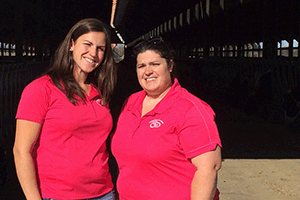
Beyond the Barn: Focus on Health and Prevention 12 Months of the Year
Breast cancer risk factors
According to the Office of Women’s Health (OWH) at the U.S. Department of Health and Human Services, several factors may affect a woman’s risk of breast cancer. The strongest of these factors is age as “most women who get breast cancer are older than 50.” Women who had breast cancer in the past are more likely to develop cancer in the other breast.
Family history also plays a role, especially if a family member had breast cancer before the age of 40. Related to that, women may inherit harmful gene mutations that greatly increase the risk of breast cancer, accounting for about 10 percent of all breast cancers. The OWH suggests seeking genetic counseling “if your family history of cancer suggests a gene mutation.”
Other factors that affect risk include certain breast changes that are not cancer, dense breast tissue, menstrual and reproductive history, use of estrogen and progestin hormones, radiation therapy to the chest, breastfeeding, and race. Click here for further details on these factors.
 Healthy choices
Healthy choices
To lower your breast cancer risk, OWH recommends focusing your efforts on a healthy lifestyle. This includes eating well-balanced meals and getting plenty of exercise. These activities also help lower bodyweight, which is another breast cancer risk factor. The OWH also recommends limiting alcohol consumption to no more than one drink per day and no smoking.
The National Breast Cancer Foundation, Inc. recommends developing an Early Detection Plan that includes monthly self-exams and regular visits to your doctor for scheduled clinical exams. Follow your healthcare provider’s recommendations for mammograms. These recommendations will depend on your age and health history. Click here to learn more about creating your Early Detection Plan.
Preventative health is important for men too
They might not get the attention that all those pink ribbons bring, but a healthy lifestyle and preventative care are equally important for men. According to the Agency for Healthcare Research and Quality, “men are 24 percent less likely than women to have visited a doctor within the past year,” “28 percent more likely than women to be hospitalized for congestive heart failure,” and “32 percent more likely than women to be hospitalized for long-term complications of diabetes.”
The Agency recommends the same healthy lifestyle choices for men: Be physically active, eat a healthy diet, stay at a healthy weight, drink alcohol in moderation or not at all, and don’t smoke. Furthermore, regularly visit your doctor to discuss what preventative care and screenings make sense for you. These might include a measure of your body mass index, cholesterol and blood pressure. Other tests may evaluate your risk of cardiovascular disease, colorectal and other cancers, diabetes, and other common men’s health concerns. Click here for more information on men’s health issues.
Everyone’s to-do list seems never-ending and farms never have a shortage of work to be done. However, taking a few hours for preventative healthcare now can keep you and your loved ones “running full speed” for years to come.
| Category: |
Employee management Safety Starting Strong - Calf Care |

